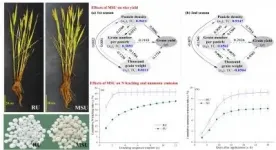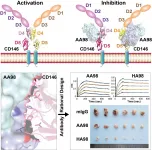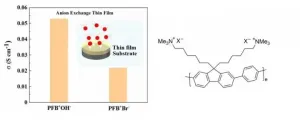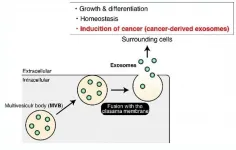(Press-News.org) More than ever, patients are using telehealth to ask doctors and nurses about worrying blood-pressure readings, nauseating migraines and stubborn foot ulcers. But for patients with chronic conditions, how frequent should telehealth appointments be? Can that frequency change? Under what conditions?
West Virginia University researcher Jennifer Mallow is trying to answer these questions. In a new project, she and her colleagues completed a systematic review of studies that dealt with telehealth and chronic conditions. They found that--in general--telehealth services benefitted patients more if they continued for about a year, rather than ending after six months or so. But perhaps their most significant finding was just how much we have left to discover.
"As researchers, we recognized there is a gap in the current science," said Mallow, an associate professor in the School of Nursing's Adult Health Department. "We don't know how much or how often telehealth should be used to impact outcomes yet. So, we needed to do the work in order to push what we know about telehealth forward."
Their findings appear in E-Health Telecommunication Systems and Networks.
The systematic review included "quasi-experimental" tests as well as randomized controlled trials. It encompassed three types of telehealth services: synchronous (including real-time videoconferencing), asynchronous (such as exchanging messages) and remote patient monitoring (reviewing readings from devices like glucometers).
Regardless of the form telehealth took, Mallow and her team found that it produced positive results in patients who received the services for 51 weeks. In contrast, telehealth durations of 37 or 38 weeks produced mixed or neutral results.
But the data weren't plentiful enough for the researchers to draw any conclusions about the best dose of telehealth to improve care effectiveness, quality, safety and cost. For instance, how often--and for how long--should a patient with diabetes use remote patient monitoring to submit her blood sugar readings to her healthcare provider? What if her readings have been healthy and stable for a month? What if they've worsened for a week? What if she has high blood pressure in addition to diabetes?
"Even though we've been doing the ramp-up of telehealth for over a year, we still don't have the answers to these questions," Mallow said. "It's because this is implementation science. This is not work that's done in the lab. So, my plea--during the booming amount of work that's being done in telehealth research--is that we need to measure dose in standard and specific ways."
Mallow and her team are doing just that. As part of the "Take Me Home, West Virginia" program, they are delivering telehealth services to West Virginians, tracking those services and identifying how they influence particular health metrics.
The program is federally funded by the Centers for Medicare and Medicaid Services. It supports state Medicaid programs--including the West Virginia Department of Health and Human Resources' Bureau for Medical Services--to give older adults and people with disabilities a greater choice in where they get long-term care.
"We're collecting information related to dose," Mallow said. "How long do we spend with participants? What are the nurses doing, and how long does it take them? How long does it take us to review remote patient monitoring? Are we talking to patients on the phone? As we collect this information in a standard way, we can begin to make those links between dose and outcome."
Ben Klos--a registered nurse, faculty member in the School of Nursing and member of Mallow's research team--provides clinical services to the telehealth patients through the "Take Me Home, West Virginia" program. He spends much of his time reviewing telehealth patients' records and following up with them when symptoms arise.
"Our participants get sent a tablet, which helps them collect their vitals--mostly blood pressure, pulse and oxygen levels--and asks them disease-specific questions," Klos said. "If I see an abnormality in their vitals or answers, I call and check on them. For us, dosing helps us understand how long an intervention should be to benefit the patient while preventing device fatigue."
Another part of Klos' job is calling patients every two weeks to collect survey data about their alcohol use and signs of anxiety, depression and loneliness. Those phone calls can be especially important for patients with more than one chronic condition because, as a group, those patients score higher than average on measures of loneliness.
"We know that people with multiple chronic conditions have higher loneliness scores and that these scores are linked to functional decline, depressive symptoms and poorer physical health outcomes, including higher blood pressure," said Laurie Theeke, a professor and director of the Ph.D. Program at the School of Nursing, and part of the research team. "Using telehealth to connect with chronically lonely people in a way that works to diminish loneliness and enhance their perception of belonging could be key to improving measures of chronic illness control."
Telehealth could also be key to addressing some of the health problems that bedevil West Virginia. The state consistently has some of the highest rates of diabetes, obesity, coronary heart disease, COPD and other chronic conditions. In addition, it ranks sixth in the nation for poverty.
"Lack of access to healthcare services, transportation options and social supports are social determinants of health that have contributed to health disparities such as heart disease, diabetes and depression in West Virginia," said Steve Davis, an associate professor in the School of Public Health who was involved with the study. "Telehealth has the potential to address these service and support gaps."
For instance, telehealth could improve rural patients' access to medical specialists--like cardiologists, neurologists, endocrinologists and psychiatrists--whose offices are a long drive away.
That's particularly important because, as the Association of American Medical Colleges reports, three out of five federally designated health-professional-shortage areas are in rural locations.
"If you're going to use telehealth for chronic conditions, the various professional bodies need to come out with recommendations for when and how often," Mallow said. "The American Diabetes Association might say you should see your patients in person at least once per year to do a foot exam but could use telehealth for other follow-up care, for example. But before they do that, we need rigorous research studies so that they can make those determinations."
INFORMATION:
Citation
Title: Dose of Telehealth to Improve Community-Based Care for Adults Living with Multiple Chronic Conditions: A Systematic Review
DOI: https://doi.org/10.4236/etsn.2021.101002
Link: https://www.scirp.org/journal/paperinformation.aspx?paperid=107679
A comprehensive review into what we know about COVID-19 and the way it functions suggests the virus has a unique infectious profile, which explains why it can be so hard to treat and why some people experience so-called "long-COVID", struggling with significant health issues months after infection.
There is growing evidence that the virus infects both the upper and lower respiratory tracts - unlike "low pathogenic" human coronavirus sub-species, which typically settle in the upper respiratory tract and cause cold-like symptoms, or "high pathogenic" viruses such as those that cause SARS and ARDS, which typically settle in the lower respiratory tract.
Additionally, more frequent multi-organ impacts, and blood clots, and ...
Which wound cuts deeper: the loss of an only child or loss of a spouse? A new study led by researchers at NYU Rory Meyers College of Nursing and Fudan University suggests that Chinese parents find the loss of an only child to be approximately 1.3 times as psychologically distressing than the loss of a spouse. The findings are published in the journal Aging & Mental Health.
Older adults in China rely heavily on family support, particularly from their adult children. Filial piety--the Confucian idea describing a respect for one's parents and responsibility for adult children to care for ...
Observing how cells stick to surfaces and their motility is vitally important in the study of tissue maintenance, wound healing and even understanding how cancers progress. A new paper published in EPJ Plus, by Raj Kumar Sadhu, Weizmann Institute of Science, Rehovot, Israel, takes a step towards a deeper understanding of these processes.
"Cell adhesion is the ability of a cell to stick to another cell or an extracellular matrix. This process is important in order to understand how cells interact and coordinate their behaviour in multicellular organisms," says sadhu. "We theoretically model the adhesion of a cell-like vesicle by describing the cell as a three-dimensional vesicle adhering on a flat substrate with a constant adhesion interaction."
Alongside ...
Neuroblastoma is a childhood cancer, most commonly affecting children aged between 2 -3 and can be fatal. Since the tumour cells resemble certain cells in the adrenal glands, a joint research group from MedUni Vienna's Center for Brain Research and the Swedish Karolinska Institute investigated the cellular origin of these cells and sympathetic neurons during the embryonic development of human adrenal glands. During the course of their investigations, they discovered a previously unknown cell type that might potentially be the origin of the tumour cells.
Treatments for this disease are extremely aggressive and challenging ...
The applied nitrogen in crop production is easily lost through ammonia emission and nitrogen leaching. Therefore, many attempts have been made on the development of novel slow-release fertilizers to reduce nitrogen loss and improve crop production.
A research team led by Prof. WU Yuejin from the Institute of Intelligent Machines of the Hefei Institutes of Physical Science developed a novel matrix-based slow-release urea (MSU) recently to improve nitrogen use efficiency in rice production, and they assessed the performances of it.
"MSU is a promising fertilizer for rice production," said WU, "as less nitrogen loss and greater soil nitrogen ...
Physicists at Friedrich-Alexander-Universität Erlangen-Nürnberg (FAU) have for the first time been able to prove a long-predicted but as yet unconfirmed fundamental effect. In Faraday chiral anisotropy, the propagation characteristics of light waves are changed simultaneously by the natural and magnetic-field induced material properties of the medium through which the light travels. The researchers obtained proof that this is the case by conducting experiments using nickel helices at the nanometre scale. Their findings have now been published in the academic journal 'Physical Review Letters'.
Light is transmitted as sine waves consisting of crossed electric and magnetic fields and interacts with matter. This ...
Recently, Prof. XIE Can from the High Magnetic Field Laboratory of the Hefei Institutes of Physical Science (HFIPS), in a collaboration with Prof. YAN Xiyun's lab from the Institute of Biophysics, reported the structural basis of mAb AA98's inhibition on CD146-mediated endothelial cells (EC) activation and designed higher affinity monoclonal antibody HA98 for cancer treatment.
CD146 is an adhesion molecule that plays important roles in angiogenesis, cancer metastasis, and immune response. Prof. YAN Xiyun's lab has been focused on the function of CD146 and the mechanism ...
Australia, the driest inhabited continent, is prone to natural disasters and wild swings in weather conditions - from floods to droughts, heatwaves and bushfires.
Now two new Flinders University studies of long-term hydro-climatic patterns provide fresh insights into the causes of the island continent's strong climate variability which affect extreme wet or dry weather and other conditions vital to water supply, agriculture, the environment and the nation's future.
For the first time, researchers from the National Centre for Groundwater Research and Training (NCGRT) at Flinders have revealed a vegetation-mediated seesaw wetting-drying phenomenon between eastern and western Australia. ...
Ishikawa, Japan - As decarbonization progresses rapidly in the world, fuel cells offer potentially higher electrical efficiency than conventional power-generating systems. Anion exchange membrane fuel cells offer advantages of using non-precious metal catalysts than proton exchange membrane fuel cells. One of the challenges of this next-generation fuel cell is to clarify the hydroxide ion conductivity in the ion conductive polymer around the electrode catalyst. The difficulty of studying the hydroxide ion conductivity at the electrode interface is that the hydroxide ion, which is a carrier, easily reacts with carbon dioxide in the air. To solve this problem, all evaluation devices were improved so that the sample did not come into contacting with air.
In a new study published ...
Cells talk to each other to coordinate nutrition, waste removal, energy use, and, in some cases, disease progression. The cells that line the surfaces of organs or specific tissues, called epithelial cells, appear to speak two different languages - one for either side of the cell, according to a new study by researchers based in Japan.
The discovery, published on March 16 in EMBO Reports, could have implications for understanding how cancer spreads and, potentially, for advanced treatments, the team says.
The team, led by Mitsunori Fukuda, professor in the Laboratory of Membrane Trafficking Mechanisms, Department of Integrative ...




